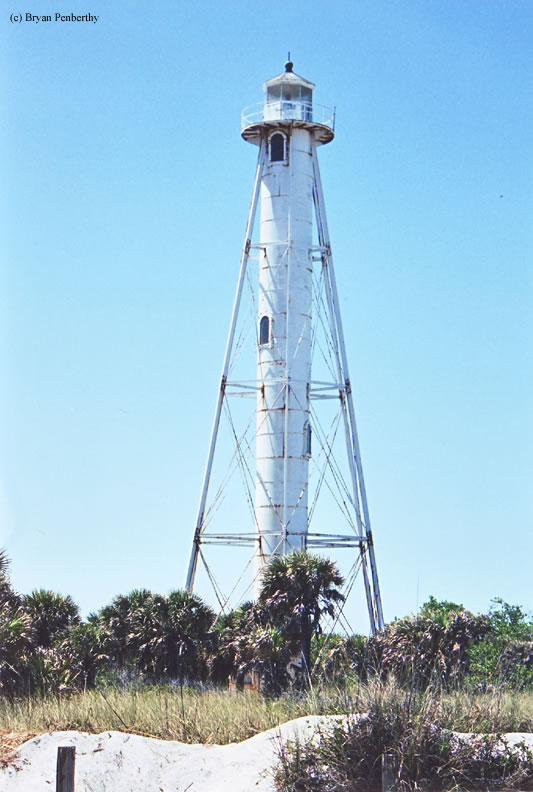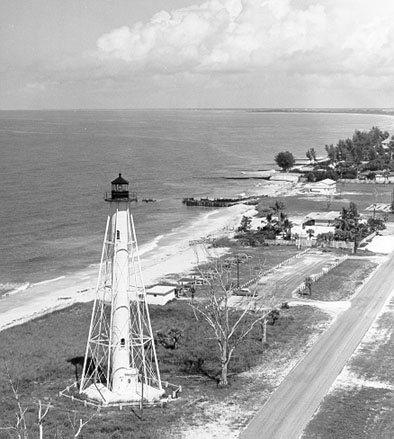Boca Grande Rear Range (Gasparilla Island) Lighthouse
Gasparilla Island, Florida - 1881 (1932**)

History of the Boca Grande Rear Range (Gasparilla Island) Lighthouse
Posted/Updated by Bryan Penberthy on 2016-01-04.
Rather than starting in 1932, the history of the Port Boca Grande Rear Range Lighthouse actually starts more than 50 years prior near Lewes, Delaware, where it served as a range light, guiding vessels into Delaware Bay.
In late 1880, Congress appropriated $20,000 to establish a set of range lights to guide vessels past Cape Henlopen and into Delaware Bay. On March 17, 1881, the Lighthouse Board awarded a contract to the Phoenix Iron Company, of Trenton, New Jersey to construct and erect the iron tower.
The Delaware Breakwater Rear Range Light, known to locals as the Green Hill Light, was paired with the Delaware Breakwater West End Light until 1903. Due to the changing shoreline of Cape Henlopen, after 1903, the rear range light was paired with the Delaware Breakwater East End Light.
The shoreline around Cape Henlopen was in a constant state of flux and by 1918, the Delaware Breakwater Rear Range Light was no longer needed by shipping interests and was discontinued that year. The third-order Fresnel lens and its clockwork mechanism, once removed, was shipped to San Francisco, California, to be used in eighteenth lighthouse district.
In 1885, phosphate rock was discovered along the banks of the Peace River in Florida, which was a valuable mineral for use in fertilizers and was in high demand throughout the world. For years, the phosphate was barged down the river to Port Boca Grande on the southern tip of Gasparilla Island.
 Boca Grande Rear Range Light (Courtesy Coast Guard)
Boca Grande Rear Range Light (Courtesy Coast Guard)
By the early 1900s, planning was underway to run a rail line to Gasparilla Island, as it was deemed more economical to ship the product via rail. Construction of the rail line began in 1905 and by 1907, the railroad terminus and a 1,000-foot-long pier was built near the Gasparilla Island Lighthouse, at the southern tip of the island.
The phosphate-laden trains were off-loaded directly onto ocean-going freighters. This improved process led to more vessels calling at the port, which necessitated the need to have the area better marked for navigation.
As the Delaware Breakwater Rear Range Lighthouse was no longer needed in the fourth lighthouse district, other districts were notified of its availability. The seventh district, which encompasses Florida, put in for the for the 100-foot tower, citing a need for Gasparilla Island.
While the iron tower was being dismantled, each piece was marked and numbered for easy reassembly. However, as funds weren't available for shipping and reassembly, it was stored at the Lighthouse Depot in Lewes, Delaware.
In 1921, funds became available, and the components were loaded onto a rail car, where they were shipped south to Miami, Florida. Several years later, it was transported north to Gasparilla Island, on Florida's Gulf Coast, where it was reassembled in 1927.
While the tower was in use in Delaware, it acted as the rear light of a range system. In Florida, it was employed in a similar way. It became the rear light of the Boca Grande Range system, while the front light of the range was a 20-foot tower, offshore in the Gulf of Mexico.
Although the lighthouse was reassembled in 1927, it's unclear why it wasn't relit until 1932. When the tower was placed back into service, it was painted white and outfitted with a fourth-order Fresnel lens. The pair of range lights guided vessels into the deep-water port of Port Boca Grande in Charlotte Harbor.
Over the years, shipments out of Port Boca Grande continued, and by 1969, Port Boca Grande was ranked as the fourth-busiest port in Florida. Starting in the 1970s, phosphate companies increasingly switched their interests to northern ports largely around the Tampa Bay area, and by 1979, Port Boca Grande was no longer used for phosphate transportation.
The port continued to be used by Florida Power and Light through 2001 as an oil storage terminal. By 2003, the front range light of the Boca Grande range was discontinued. The Coast Guard had planned to demolish the aging structure in 2004, but their plans were met with public outcry from local residents and boaters alike and they quickly reversed their decision.
In 1989, the Barrier Island Parks Society (BIPS) was founded with the goal of turning the 1890 Port Boca Grande Lighthouse into a museum displaying the history of Charlotte Harbor. By 1999, the goal had been realized. The group is currently going through the process of trying to license the Gasparilla Island Lighthouse from the U.S. Coast Guard with the intention of fully restoring the light to its original 1927 condition.
Today, the rear range lighthouse is known as the Gasparilla Island Lighthouse. It is still maintained as an aid to navigation by the U.S. Coast Guard station St. Petersburg Aids to Navigation Team.
Why were both lighthouses called Gasparilla Island Lighthouse?
There are currently two lighthouses on Gasparilla Island. On the southern tip of the island, there is a screwpile-stlye lighthouse that dates from 1890. This lighthouse was originally called the Gasparilla Island Lighthouse. There is also an iron skeletal lighthouse a mile to the north. When it was constructed in 1927, was given the name Boca Grande Rear Range Lighthouse.
The 1890 Gasparilla Island Lighthouse was decommissioned in 1966 as it was no longer needed. After the lighthouse was fully restored in 1986, it was reactivated. Due to a clerical error by a Coast Guard clerk, a history of the light was never checked, and as the locals had frequently called it Port Boca Grande, the clerk reinstated the lighthouse with the name Port Boca Grande Lighthouse.
When the 1927 skeletal tower was decommissioned as a range light, it was renamed the Gasparilla Island Lighthouse, forever causing confusion.
In short, both lighthouses on the barrier island have been called the Gasparilla Island Lighthouse.
Reference:
- "Charlotte Harbor Lighthouse, Florida," Neil E. Hurley, Lighthouse Digest, March 2007.
- Northeast Lights - Lighthouses and Lightships, Robert G. Bachand, 1989.
- Annual Report of the Light House Board, U.S. Lighthouse Service, Various years.
- Guiding Lights of the Delaware River & Bay, Jim Gowdy & Kim Ruth, 1999.
- "Megalodon's Lighthouse," Michael Salvarezza, Lighthouse Digest, January/February 2015.
Directions: The lighthouse is in Gasparilla Island State Park, on Gasparilla Island. From I-75, exit at North Toledo Blade Blvd. From there, head south to Route 776. Now follow Route 776 west to where it eventually turns into Route 771 and heads onto Gasparilla Island. Once on the island, the lighthouse stands alongside Gulf Blvd between Wheeler Road and Seabreeze Ct. There was a $6.00 toll to get onto the island, and then a small fee for the lighthouse.
Access: The lighthouse is owned by the state of Florida. Grounds open, tower open for climbing. Pricing and dates available here: http://www.bocagrandehappenings.org/events/climb-gasparilla-island-lighthouse/
View more Boca Grande Rear Range (Gasparilla Island) Lighthouse picturesTower Height: 100.00'
Focal Plane: 105'
Active Aid to Navigation: Yes
*Latitude: 26.74200 N
*Longitude: -82.26340 W
See this lighthouse on Google Maps.
